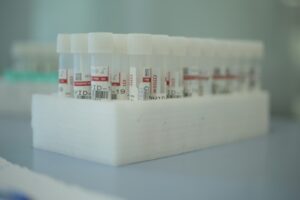
COVID-19 diagnostics: preserving manufacturing capacity for future pandemics
Manufacturing capacity for diagnostics increased at a rapid rate during the COVID-19
Once in-vitro diagnostics (IVDs) are quality assured and countries have policies in place to deploy diagnostic tools and technologies, products must be made available for purchase. Availability is critical for consumption and commercialization. For optimal diagnostic impact, products need to be in widespread use. Products thus need to be manufactured and produced in volumes based on global and national requirements.
The onset of the COVID-19 pandemic was a watershed moment in global health as it spurred extraordinary development and deployment of IVD tools and technologies. Initially, molecular testing was the only option available, and many countries were overwhelmed by unprecedented demands on laboratories and testing facilities. Molecular testing requires central laboratory systems, a high level of expertise, well-developed infrastructure, additional equipment, robust specimens, and results referral networks. As a consequence, turnaround times to receive results often lagged, taking days or even weeks in certain settings.
To address the need for faster results return and relieve the burden on the healthcare system through decentralized access to testing, antigen-detection rapid diagnostic tests or AgRDTs were developed for both professional and self-test use. However, the lack of diversity in test manufacturers, particularly in low- and middle-income settings, and limited competition in the market meant that these countries were often left without access to timely tests needed to protect their populations effectively in the fight against the COVID-19 pandemic.
Without the ability to produce COVID-19 IVD tools and technologies, countries were unable to access regulatory approved tests. To address the manufacturing challenge, the ACT-A Diagnostics Pillar launched a worldwide call for expressions of interest to drive equitable access and global supply of fit-for-purpose antigen-detecting rapid diagnostic tests for COVID-19.
With the support of partners, the following key activities were prioritized to support manufacturing efforts:
Manufacturing investments for COVID-19 IVD tools and technologies supported the scaling of manufacturing capacity and technology transfer projects across multiple manufacturers and countries. This has increased equitable access and purchase of COVID-19 products. Notable manufacturing achievements are highlighted. To learn more about the manufacturing achievements and work, refer to the key learnings and resource section below.
partner manufacturers across various product classes
countries engaged in local manufacturing and technology transfer projects
LMIC manufacturers selected for technology transfer for C-TAP licenses
licenses via COVID-19 Technology Access Pool (C-TAP)
COVID-19 professional use antigen RDTs available to LMICs
COVID-19 self test antigen RDTs available to LMICs
Leveraging the ACT-Accelerator experience, there are key lessons to expand the use of diagnostic tools and technologies for COVID-19 as well as other diseases of endemic and pandemic potential.

Manufacturing capacity for diagnostics increased at a rapid rate during the COVID-19

Rapid tests are a fast and accurate way to diagnose patients in
© All Rights Reserved 2023
The ACT-A Dx Knowledge Hub is hosted by FIND on behalf of the ACT-Accelerator Diagnostics Pillar partnership.